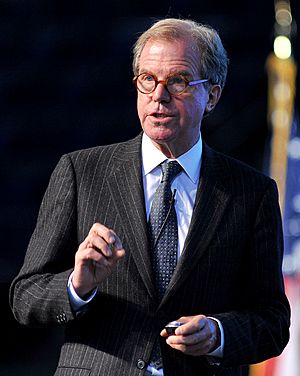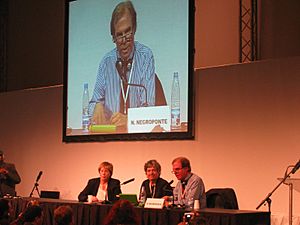Nicholas Negroponte facts for kids
Quick facts for kids
Nicholas Negroponte
|
|
|---|---|

Nicholas Negroponte delivering the Forrestal Lecture to the US Naval Academy in Annapolis, MD, on April 15, 2009
|
|
| Born | December 1, 1943 |
| Occupation | Academic and computer scientist |
| Children | Dimitri Negroponte |
Nicholas Negroponte, born on December 1, 1943, is a Greek-American architect and computer scientist. He is famous for starting the MIT Media Lab at the Massachusetts Institute of Technology. He also created the One Laptop per Child (OLPC) project. Negroponte wrote a popular book called Being Digital in 1995, which was translated into many languages.
Contents
Early Life and Education
Nicholas Negroponte grew up in New York City. His father, Dimitrios Negropontis, was a Greek shipping business owner and a skilled skier. Nicholas has three brothers. His older brother, John Negroponte, used to be a high-ranking official in the United States government. His brother Michel Negroponte is a filmmaker who has won awards. His brother George Negroponte is an artist.
Nicholas went to several schools, including Buckley School in New York and The Choate School in Connecticut. He then studied at MIT, where he focused on how computers could help with design.
In 1964, while still a student, he talked about his idea for an "Architecture Machine." This machine would work with humans to design buildings. It was like a partner that could learn and grow with a person during the design process. He earned his master's degree in architecture from MIT in 1966. Even though he did well in school, Negroponte has shared that he has dyslexia, which made reading difficult for him.
Career at MIT
Nicholas Negroponte joined the faculty at MIT in 1966. For several years, he also taught at other universities like Yale and the University of California, Berkeley. He also worked with IBM to explore how computers could help architects and designers.
Architecture Machine Group
In 1967, Negroponte started the Architecture Machine Group at MIT. This group was like a special lab that studied new ways for people and computers to work together. They especially looked at how computers could be used in architecture. Negroponte believed that computers could do more than just make design faster. He wanted to explore how machines could become creative partners in architectural design.
The group received funding from organizations like DARPA to research early ideas in human-computer interaction and virtual reality. Their research was shared in two books: The Architecture Machine: Towards a More Human Environment (1973) and Soft Architecture Machines (1976).
Founding the Media Lab
In 1985, Negroponte co-founded the MIT Media Lab with Jerome B. Wiesner. As the director, he helped the lab become a leading place for new media and technology. The Media Lab explored how humans and computers could interact in exciting new ways. Negroponte also supported the idea of "intelligent agents" and personalized online newspapers, which he called the "Daily Me." This was a vision of a newspaper that would automatically gather news just for you.
Wired Magazine and Being Digital
In 1992, Nicholas Negroponte was one of the first people to invest in Wired Magazine. From 1993 to 1998, he wrote a monthly column for the magazine. His main idea was "Move bits, not atoms," meaning that digital information (bits) would become more important than physical things (atoms).
Negroponte expanded on these ideas in his bestselling book Being Digital (1995). The book became very famous for predicting how the internet, entertainment, and information would all come together. Being Digital was a huge success and was translated into about forty languages. Negroponte was very optimistic about technology, believing that computers would improve life for everyone.
In the 1980s, Negroponte made a prediction called the "Negroponte switch." He said that wired technologies like telephones would become wireless, using airwaves. And wireless technologies like televisions would become wired. This prediction has largely come true.
Later Career and One Laptop Per Child
In 2000, Negroponte stepped down as director of the MIT Media Lab, but he remained the chairman for a few years. In 2006, he left his chairman role to focus more on his work with One Laptop Per Child (OLPC). He is still a professor at MIT.
In November 2005, Negroponte introduced the idea of a $100 laptop computer. This computer, called The Children's Machine, was designed for students in developing countries. The price later increased to about $180. This project was part of the One Laptop Per Child program, a non-profit organization started by Negroponte and others from the Media Lab. Their goal was to help more children in developing countries get access to the internet and education.
Negroponte has also invested in many startup companies over the years. These include well-known companies like Skype and Wired. He has also served on the boards of companies like Motorola.
In 2007, he was appointed to a special committee to help ensure the independence of the Wall Street Journal and other publications after their merger with News Corporation.
See also
 In Spanish: Nicholas Negroponte para niños
In Spanish: Nicholas Negroponte para niños


